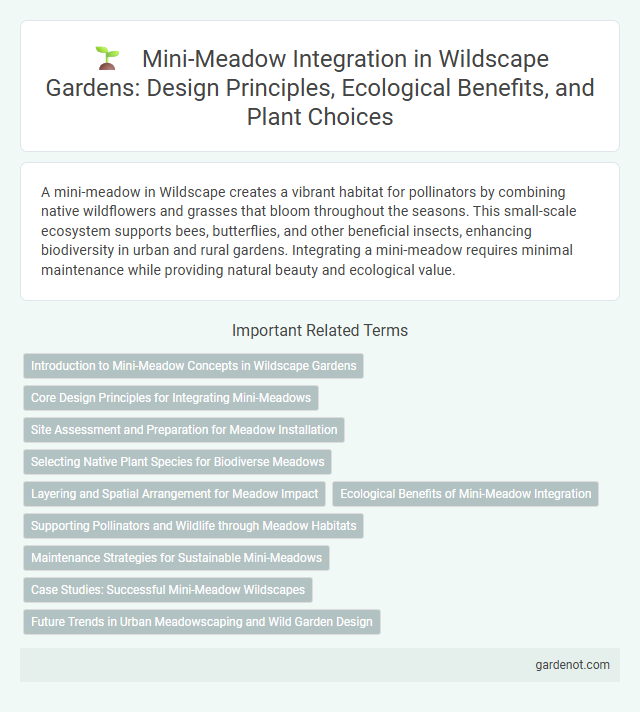A mini-meadow in Wildscape creates a vibrant habitat for pollinators by combining native wildflowers and grasses that bloom throughout the seasons. This small-scale ecosystem supports bees, butterflies, and other beneficial insects, enhancing biodiversity in urban and rural gardens. Integrating a mini-meadow requires minimal maintenance while providing natural beauty and ecological value.
Introduction to Mini-Meadow Concepts in Wildscape Gardens
Mini-meadows in Wildscape Gardens are compact, biodiversity-rich ecosystems designed to support native pollinators and enhance urban wildlife habitats. These small-scale wildflower patches integrate native grasses and flowering plants, promoting ecological balance through natural pest control and soil enrichment. Emphasizing low-maintenance and water-efficient landscaping, Mini-meadows contribute to sustainable garden design while fostering greater environmental connectivity within residential and community spaces.
Core Design Principles for Integrating Mini-Meadows
Mini-meadows enhance biodiversity by creating diverse habitats that support pollinators, small mammals, and native flora within urban and wildscape environments. Core design principles emphasize native plant selection, layered vegetation structures, and minimizing soil disturbance to promote ecological resilience and natural regeneration. Strategic placement near water sources and thoughtful maintenance schedules ensure sustained growth and integration within larger landscape ecosystems.
Site Assessment and Preparation for Meadow Installation
Conducting a thorough site assessment identifies soil quality, sunlight levels, and existing vegetation critical for mini-meadow success. Preparing the site includes removing invasive species, loosening the soil, and amending it with organic matter to promote native wildflower growth. Proper site preparation ensures optimal conditions for biodiversity, pollinator attraction, and sustainable meadow establishment.
Selecting Native Plant Species for Biodiverse Meadows
Selecting native plant species for mini-meadows enhances local biodiversity by providing habitat and food sources for pollinators, birds, and other wildlife. Native plants are adapted to the local climate and soil, requiring less maintenance and promoting healthier ecosystems. Incorporating a diverse mix of grasses, wildflowers, and ground covers native to the region ensures a resilient and vibrant mini-meadow that supports ecological balance.
Layering and Spatial Arrangement for Meadow Impact
The Mini-meadow utilizes strategic layering and spatial arrangement to maximize visual and ecological impact within limited spaces. Diverse plant heights and textures are arranged in tiers, creating depth and enhancing habitat complexity for pollinators. Thoughtful placement of native wildflowers and grasses promotes biodiversity while ensuring seasonal interest and resilience.
Ecological Benefits of Mini-Meadow Integration
Mini-meadows enhance biodiversity by providing crucial habitats for pollinators such as bees and butterflies, supporting local ecosystems. Their diverse native plant species improve soil health through natural nitrogen fixation and erosion control, promoting long-term ecological stability. Integrating mini-meadows into urban landscapes also aids in carbon sequestration and mitigates the urban heat island effect, contributing to climate resilience.
Supporting Pollinators and Wildlife through Meadow Habitats
Mini-meadows create vital habitats that support pollinators like bees, butterflies, and hoverflies by providing diverse nectar sources and shelter. These compact meadow spaces enhance biodiversity, offering refuge and breeding grounds for various wildlife species within urban and garden environments. Establishing mini-meadows contributes to sustaining local ecosystems and improving pollination services crucial for plant reproduction and food production.
Maintenance Strategies for Sustainable Mini-Meadows
Sustainable mini-meadows require regular monitoring of soil health and native plant species to promote biodiversity and resilience. Strategic maintenance involves selective mowing schedules, avoiding over-fertilization, and controlling invasive species to preserve ecological balance. Incorporating seasonal assessments helps adapt management practices, ensuring long-term habitat sustainability and pollinator support.
Case Studies: Successful Mini-Meadow Wildscapes
Mini-meadow Wildscapes have demonstrated remarkable success in enhancing urban biodiversity by transforming underutilized green spaces into thriving habitats for pollinators and native flora. Case studies highlight increased populations of bees, butterflies, and other beneficial insects within months of installation, supporting ecosystem resilience and local food webs. These mini-meadows also contribute to improved soil health and reduced maintenance costs compared to traditional lawns, making them sustainable solutions for urban ecological restoration.
Future Trends in Urban Meadowscaping and Wild Garden Design
Future trends in urban meadowscaping highlight the integration of mini-meadows as key components in sustainable wild garden design. These small-scale, biodiverse habitats support pollinators and native wildlife, improving urban ecological health while requiring minimal maintenance. Advances in seed mix formulations and soil health management enhance the resilience and aesthetic appeal of mini-meadows within urban landscapes.
Mini-meadow Infographic

 gardenot.com
gardenot.com